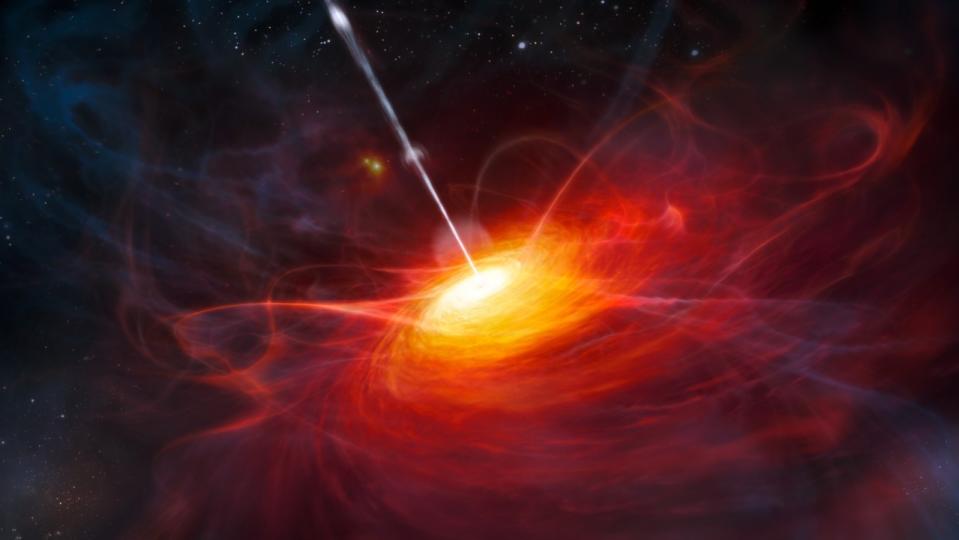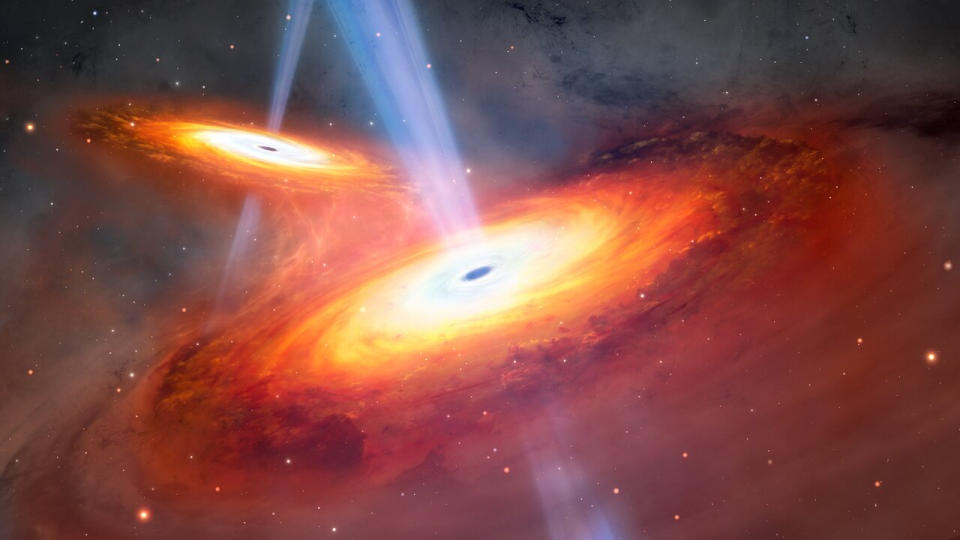Quasars, the brightest objects in the universe, could act as cosmic signposts, directing astronomers to elusive pairs of supermassive black holes.
Although scientists are aware that supermassive black holes with masses millions or even billions of times that of the sun reside at the hearts of most, if not all, large galaxies, binary pairs of these cosmic titans are difficult to detect. That’s because supermassive black hole binaries are incredibly rare. After all, these behemoths are created by mergers that begin when galaxies collide. That means there must be a large population of supermassive black hole binaries waiting to collide and create an even more monstrous daughter supermassive black hole. But where are they?
New research suggests that quasars — the luminous hearts of active galaxies powered by supermassive black holes — could hold the answer. The team behind the research thinks that galaxies with quasars are seven times more likely to host supermassive black holes than other galaxies.
The findings could help in the search for these monstrous duos using gravitational waves, tiny ripples in space and time (bundled together into a four-dimensional entity called space-time) that were first predicted in Einstein’s general theory of relativity in 1915.
“These findings are useful for targeted searches for supermassive black hole binaries, where we search specific galaxies and quasars for continuous gravitational waves from individual supermassive black hole binaries,” lead researcher Andrew Casey-Clyde, a doctoral candidate at the University of Connecticut and a visiting scholar at Yale University, told Space.com.
“Our results mean that these targeted searches are up to seven times more likely to find gravitational waves from a supermassive black hole binary in a quasar than in any massive galaxy,” Casey-Clyde said.
Related: Strangely wobbly jets could be evidence of elusive combinations of supermassive black holes
Ironically, the team’s discovery began with a somewhat disappointing finding. In 2015, the Catalina Real-time Transient Survey (CRTS), conducted by three telescopes covering a large portion of the sky, suggested that 111 quasars with periodic light curves could contain supermassive black holes as binaries.
However, Casey-Clyde and colleagues determined that most of these binary quasar candidates were likely false detections, based on the recently measured hum of the universe, the so-called “gravitational wave background.”
“Even after correcting for the large number of false positives in the CRTS candidate binaries, this work shows that quasars are more likely to host supermassive black holes than random galaxies,” Casey-Clyde said.
Supermassive black holes hid behind the brightest objects in the universe
Some supermassive black holes are surrounded by a huge amount of material, in the form of a flattened cloud of gas and dust called an accretion disk, which gradually feeds them with matter. The immense gravitational influence of these supermassive black holes generates powerful tidal forces in accretion disks, creating friction that heats this material and causes it to glow brightly across the electromagnetic spectrum.
In addition, material that is not fed into the black hole is funneled toward the poles, where it is ejected as highly collimated, high-energy jets. These jets also emit electromagnetic radiation. As a result of these phenomena, these central galactic regions, called “active galactic nuclei” (AGNs), which are seen as quasars, can be so bright that they outshine the combined light of every star in the galaxy surrounding them.
Often, the supermassive black hole will party and generate a quasar because it is in a galaxy that has merged with another galaxy of similar size. This collision acts as a cosmic Grubhub, bringing a fresh supply of gas and dust to the black hole. The galactic merger also brings two supermassive black holes close together.
Binary quasars are systems of double stars containing supermassive black holes, with associated quasar activity from an accretion disk surrounding both supermassive black holes in the binary star system.
“We know that quasars can be caused by large mergers of galaxies, where
two galaxies of similar mass merge. These mergers also lead to the
eventual formation of a supermassive black hole binary,” Casey-Clyde said. “Since supermassive black hole binary systems are formed by massive mergers of galaxies, and quasars can be energized by those mergers, this suggests that some quasars may be associated with supermassive black hole binary systems.”

Binary stars of supermassive black holes do not like too bright quasars
For this study, the team specifically looked at quasars with light outputs that repeat over time, emissions known as periodic light curves. Simulations have suggested that periodic light curves associated with quasars could be the signature of a supermassive black hole binary. Integral to their study was a collection of very precisely rotating neutron star pulsars called the NANOGrav pulsar array. By spinning hundreds of times per second, pulsars can be used as a very sensitive cosmic stopwatch when viewed en masse.
Last year, the NANOGrav pulsar array detected the faint background gravitational wave signal from distant black hole mergers, and the team was able to use this detection to constrain the supermassive black hole binary population. NANOGrav’s pulsars then helped the team constrain the quasar population.


Because the team used a combination of electromagnetic observations of quasars and NANOGrav pulsar array gravitational wave detections, the research is an example of ‘multi-messenger astronomy’: research into the universe using at least two completely different signals at the same time.
“Multi-messenger astronomy was crucial for constraining the binary quasar population in this work. Because binary quasars are a subset of both the quasar and supermassive black hole binary populations, constraints on either are also constraints on the binary quasar population,” Casey-Clyde said. “We have long suspected that quasars could mark supermassive black hole binaries because of the connections both have to major galaxy mergers. Now we have shown that this association is still plausible, even after considering contamination in the CRTS sample.”
The results also surprised Casey-Clyde and the team, as they found that bright quasars are less likely to host a binary star with a supermassive black hole than fainter quasars.
“The fact that the brightest binary quasar candidates are the least likely to be real was surprising. But it makes sense when you consider the rarity of supermassive black hole binaries,” Casey-Clyde said. “This is because the brightest binary quasars should be associated with the most massive supermassive black hole binaries. But the most massive supermassive black hole binaries are rare because they merge relatively quickly.”
This means that binaries of lower-mass supermassive black holes remain in the range of such objects detectable by pulsar timing arrays for longer and are therefore much more likely to be detected.
Related: What are pulsars?
RELATED STORIES:
—What is the event horizon of a black hole (and what happens there)?
—Where do black holes lead?
— Black hole beam changes direction as astronomers first peer into cosmos — and is aimed straight at us
Casey-Clyde added that targeted searches for gravitational waves are one of the most important next steps for this research. He added that the team also plans to hunt for widely separated pairs of black holes that represent the phase before a close binary of a supermassive black hole forms.
“In particular, detecting gravitational waves from a galaxy hosting a quasar will allow us to test how the orbital motion of a binary star system around a supermassive black hole imprints a
quasar’s light curve,” he said. “Searches for dual AGN will be important for constraining supermassive black hole pairs, which are widely separated progenitors of supermassive black hole binaries resulting from recent galaxy mergers.”
This will allow the team to better estimate how many supermassive black hole binaries they expect to see in the universe, and in turn, to better understand the relationship between quasars and merging galaxies.
“The Legacy Survey of Space and Time (LSST) coming soon from the Vera C. Rubin Observatory will be crucial for improving constraints on the binary quasar population,” Casey-Clyde concluded. “We will have to wait about a decade
“However, no observations are needed to do this, since the light curves of binary quasars are thought to have periods on the scale of years.”
The team’s research has been published as a pre-peer-reviewed paper on the repository site arXiv.